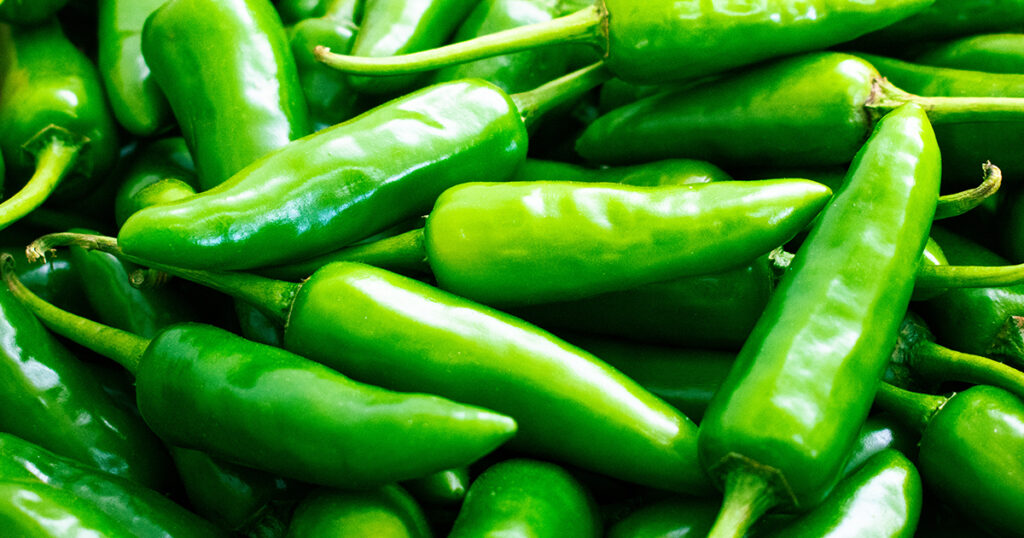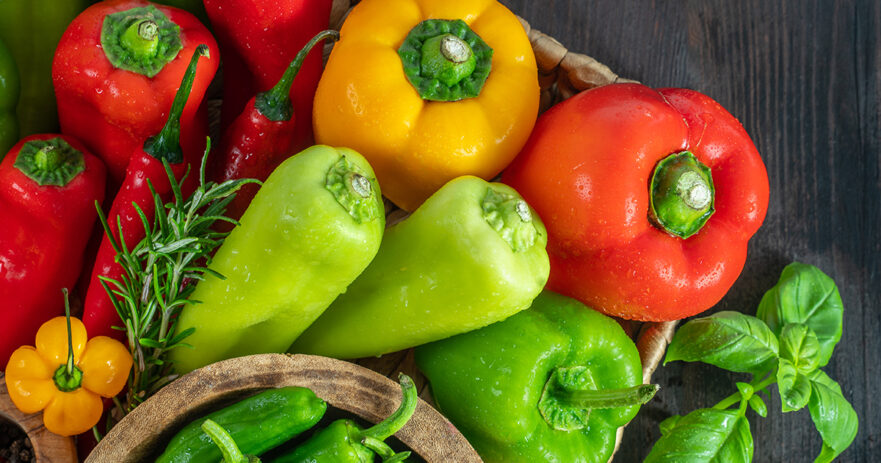Mild peppers are a delightful range of chili peppers that offer a gentle level of spiciness due to their relatively low capsaicin content [1]. Capsaicin, the compound responsible for the heat in peppers, is measured in Scoville Heat Units (SHU). Mild peppers fall within the mildly pungent range, typically ranging from 700 to 3,000 SHUs [2].
When it comes to enhancing the flavors of our meals, peppers have long been cherished as a versatile ingredient that elevates our culinary experiences. While fiery hot peppers have their devoted fans, there is a growing appreciation for the subtle allure of milder alternatives. These mild peppers offer a delicate balance of flavors, providing a gentle yet delightful touch of spice to our dishes.
In this article, we delve into the world of mild peppers, handpicking a selection that will add a subtle kick to your culinary creations without overwhelming your taste buds. So, whether you savor Anaheim’s crisp sweetness or Pimentos’s nuanced heat, get ready to explore mild peppers’ diverse and flavorful realm.
Key Takeaways
- Peppers vary in pungency, from sweet and mild to fiery hot, based on capsaicin content [1].
- Mild peppers provide a gentle yet delightful touch of spice to dishes, offering a subtle and unique flavor profile.
- Anaheim, Pimento, and Poblano peppers are integral to various cuisines and dishes, from Mexican stews to sweet paprika and stuffed olives.
- Uba Tuba comes in vibrant ruby red color and provides versatile meal flavor options [1].
- Poblano peppers are widely used in Mexican cuisine as a popular chili pepper [12].
- The Mad Hatter pepper stands out with its unique, three-sided shape and delightful citrusy floral flavor.
Rocotillo
In Puerto Rico and the West Indies, the prevalent chili pepper variety is known as ‘Rocotillo,’ which should not be mistaken for the Capsicum baccatum variety, which shares the same name. The heat of ‘Rocotillo’ is notably milder compared to the typical Scotch bonnet, measuring around 1000 SHUs (Scoville Heat Units). These plants can grow to a height of 3 to 4 feet, slightly taller than other chili pepper varieties. The pods of ‘Rocotillo’ are ideal for adding flavor to authentic Puerto Rican dishes [8].
NuMex Suave Orange
‘NuMex Suave Orange,’ also known as ‘NuMex Suave Red,’ derives its name from the Spanish word “suave,” meaning mellow, smooth, or mild. These peppers are considered some of the mildest habaneros available. They offer a typical habanero’s fantastic flavor and aroma without the intense heat. The appearance of these pods is similar to standard habanero pods, and each plant can yield up to a hundred of them.
Despite their mildness, they retain the same flavorful profile and aroma as their hotter habanero counterparts. With a heat rating of only 800 SHUs, the heat is primarily felt in the back of the mouth and throat rather than on the lips and tongue [8].
Uba Tuba
Uba Tuba, scientifically known as Capsicum baccatum, is a mild pepper known for its unique flavor. The fruit of Uba Tuba peppers takes on a novel flower-like shape and transitions from green to a vibrant ruby red as it ripens. When fully ripe, the fruit offers a delightful sweetness. Researchers at the University of Kentucky have evaluated Uba Tuba peppers for culinary and ornamental purposes. Culinary samples were shared with select chefs, particularly those serving high-end clientele. These chefs expressed great interest in using Uba Tuba peppers as appetizers, stuffing them with various ingredients. The peppers garnered attention due to their distinctive appearance and taste, which stood out among other pepper varieties. Uba Tuba peppers are equally enjoyable when consumed fresh or cooked [1].
Anaheim Pepper

Anaheim peppers, also known as New Mexican Chile, belong to the milder spectrum of peppers [1][5]. These peppers, which are longer than jalapeños, range from mild to hot in terms of spiciness. When fresh, Anaheim peppers display bright green to red colors, turning brownish red when dried [1]. Compared to other chile types, Anaheim peppers tend to have a relatively low heat level [13]. It has some ranking as low as 600-1000 Scoville Heat Units (SHU) [11]. The Anaheim, or New Mexican, peppers are characterized by their elongated, cylindrical shape, measuring approximately 7 to 9 inches long [13].
Pimento pepper
Peppers cover a wide range of spiciness, from mild to very hot, with pimento peppers (100-500 SHU) falling into the milder category [11]. Pimentos, also known as pimientos, are sweet, heart-shaped peppers that transition from green to red as they ripen. Once dried and ground, they are commonly sold as sweet paprika [1]. The spelling of pimiento can be confusing as it varies in different contexts; it is derived from the Spanish word for pepper, while the anglicized form is spelled as pimento. Pimientos find their way into various processed foods like pimiento cheese and stuffed olives, but they can also be enjoyed fresh [8].
Poblano peppers
The poblano pepper is a popular chili pepper in Mexican cuisine, known for its mild spiciness. While it contributes flavor and heat to dishes, it is not commonly used in herbal preparations. It’s important to note that the capsaicin present in peppers can cause irritation, so caution is advised when handling or using them topically. Poblano peppers contain capsaicin, like other hot peppers, which can provide a warming sensation and potentially offer relief from muscle discomfort [12]. On the Scoville Heat Unit (SHU) scale, poblano peppers typically range from 1,000 to 1,500 SHUs, placing them within the mild to moderately spicy range [11].
Banana pepper
Among the mild peppers, we have the banana pepper [14]. The Banana pepper has an average of 500 Scoville Heat Units (SHU) [17]. These peppers have elongated fruits that start as pale yellow-green and mature into a vibrant yellow or bright red color. It’s worth noting that both hot and mild (sweet) varieties of banana peppers are available [8]. In fact, certain types of hot banana peppers are sometimes called Hungarian Wax peppers [1].
Cherry pepper
One of the mild peppers is the sweet cherry pepper [14]. These peppers are named for their pod’s resemblance to large cherries. They are often pickled and commonly served as a delightful addition to sandwiches. Sweet cherry peppers on the Scoville Heat Unit (SHU) scale typically measure from 0 to about 3500 SHUs. Some gardeners cultivate cherry peppers for their ornamental appeal, as they thrive in home gardens [8].
Cubanelle Pepper
Cubanelle peppers, also known as Italian peppers, fall into the sweet to mildly hot peppers category. They have a distinctive shape, being long and somewhat flattened. As these flavorful peppers mature, they undergo a vibrant transformation, transitioning from yellow-green to orange and eventually ripening to a rich red color [1].
Pepperoncini pepper
Pepperoncini peppers measure 100 to 500 units [18]. Pepperoncini peppers are a type of pepper primarily cultivated in the southern United States. When immature, these peppers possess a mild spiciness and are used in the pickled form as a popular condiment. The demand for pepperoncini peppers has increased, especially due to their increasing popularity in salad bars across the retail and food service industries [10].
Pasilla Pepper
Pasilla dry peppers are derived from the chilaca pepper (Capsicum annuum) and are known for their mild to medium-hot spiciness. These dark-colored, sun-dried peppers possess a distinct and highly appreciated flavor. Pasilla peppers are widely used to prepare mole pastes, adding depth and richness to the traditional Mexican sauce [6]. On the Scoville Heat Unit (SHU) scale, Pasilla peppers typically range from 1000 to 1500 SHUs, placing them in the medium-hot category [8].
Mad Hatter peppers
Mad Hatter peppers are distinct in appearance, showcasing a unique, three-sided shape. These peppers offer a refreshing and delightful citrusy, floral flavor that remains predominantly sweet, with only occasional hints of mild heat near the seeds. The plants themselves are vigorous, robust, and effortless to cultivate. The bountiful fruits of Mad Hatter peppers can be enjoyed in various ways, such as adding them raw to salads, pickling them, or stuffing them with cheese for a delicious treat [7].
Summary
Are you tired of fiery peppers that leave your taste buds in agony? Discover the wide range of mild pepper varieties, from the fruity banana pepper and subtly sweet poblano pepper to the delightfully crisp Anaheim pepper and the nuanced heat of the pimento pepper. Whether you’re spicing up a salad, stuffing them with savory fillings, or incorporating them into salsas and sauces, mild peppers bring a touch of mild zing and a hint of sweetness to your dishes. Unleash your creativity and experiment with mild peppers to elevate your favorite recipes to new heights.
FAQ
What is the best mild pepper?
The best mild pepper is the Poblano pepper (C. annuum). They offer a delightful flavor and contain significant amounts of vitamins (A, E, B, and C), folic acid, and potassium. Additionally, Poblano peppers have been associated with various therapeutic effects on human health, making them a valuable crop for both culinary and wellness purposes [3].
Which chilies are mild?
Mild chilies are those that fall within the range of mildly pungent (700–3000 SHU) based on the Scoville Heat Unit (SHU) classification [2]. Mild peppers typically contain capsaicinoid concentrations ranging from 0.01% to 0.3% [16]. One example of a mild chili is the Mad Hatter pepper, known for its mild pungency.
What pepper is milder than a jalapeno?
Anaheim pepper (600-1,000 SHU) and Pimento pepper (100-500 SHU) are milder than jalapeno (2,500-8,000 SHU) with lower SHU ratings [1] [4] [11].
Why are my peppers mild?
Peppers can be mild due to lower levels of capsaicin, the compound responsible for spiciness, as measured on the Scoville Scale [11]. Peppers with mild heat levels typically have SHU ratings ranging from 700 to 3000 [2].
Which peppers are not spicy?
Peppers that are not spicy or have minimal heat are generally milder. The level of pungency or heat in peppers is determined by the amount of capsaicin they contain [11].

